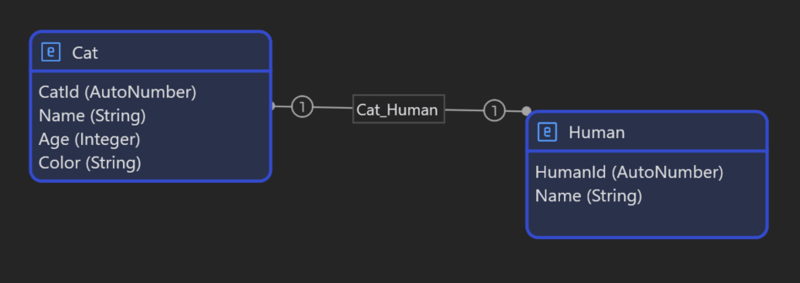将 JPA 实体转换为 Mendix
来源:dev.to
时间:2025-01-18 13:13:14 341浏览 收藏
“纵有疾风来,人生不言弃”,这句话送给正在学习文章的朋友们,也希望在阅读本文《将 JPA 实体转换为 Mendix》后,能够真的帮助到大家。我也会在后续的文章中,陆续更新文章相关的技术文章,有好的建议欢迎大家在评论留言,非常感谢!
最近在探索 mendix 时,我注意到他们有一个 platform sdk,允许您通过 api 与 mendix 应用程序模型进行交互。
这给了我一个想法,探索它是否可以用于创建我们的领域模型。具体来说,是基于现有的传统应用程序创建领域模型。
如果进一步推广,这可用于将任何现有应用程序转换为 mendix 并从那里继续开发。
将 java/spring web 应用程序转换为 mendix
因此,我创建了一个带有简单 api 和数据库层的小型 java/spring web 应用程序。为了简单起见,它使用嵌入式 h2 数据库。
在这篇文章中,我们将仅转换 jpa 实体。让我们来看看它们:
@entity
@table(name = "cat")
class cat {
@id
@generatedvalue(strategy = generationtype.auto)
private long id;
private string name;
private int age;
private string color;
@onetoone
private human humanpuppet;
... constructor ...
... getters ...
}
@entity
@table(name = "human")
public class human {
@id
@generatedvalue(strategy = generationtype.auto)
private long id;
private string name;
... constructor ...
... getters ...
}
如您所见,它们非常简单:一只有名字、年龄、颜色的猫和它的人类傀儡,因为正如我们所知,猫统治着世界。
它们都有一个自动生成的 id 字段。猫与人类有一对一的联系,这样它就可以随时呼唤人类。 (如果它不是 jpa 实体,我会放置一个 meow() 方法,但让我们将其留到将来)。
应用程序功能齐全,但现在我们只对数据层感兴趣。
提取 json 中的实体元数据
这可以通过几种不同的方式来完成:
- 通过静态分析包中的实体。
- 通过使用反射在运行时读取这些实体。
我选择了选项 2,因为它更快,而且我无法轻松找到可以执行选项 1 的库。
接下来,我们需要决定构建后如何公开 json。为了简单起见,我们只需将其写入文件即可。一些替代方法可能是:
- 通过 api 公开它。这更加复杂,因为您还需要确保端点受到很好的保护,因为我们不能公开暴露我们的元数据。
- 通过一些管理工具公开它,例如 spring boot actuator 或 jmx。它更安全,但仍然需要时间来设置。
现在让我们看看实际的代码:
public class mendixexporter {
public static void exportentitiesto(string filepath) throws ioexception {
annotatedtypescanner typescanner = new annotatedtypescanner(false, entity.class);
set<class<?>> entityclasses = typescanner.findtypes(javatomendixapplication.class.getpackagename());
log.info("entity classes are: {}", entityclasses);
list<mendixentity> mendixentities = new arraylist<>();
for (class<?> entityclass : entityclasses) {
list<mendixattribute> attributes = new arraylist<>();
for (field field : entityclass.getdeclaredfields()) {
attributetype attributetype = determineattributetype(field);
associationtype associationtype = determineassociationtype(field, attributetype);
string associationentitytype = determineassociationentitytype(field, attributetype);
attributes.add(
new mendixattribute(field.getname(), attributetype, associationtype, associationentitytype));
}
mendixentity newentity = new mendixentity(entityclass.getsimplename(), attributes);
mendixentities.add(newentity);
}
writetojsonfile(filepath, mendixentities);
}
...
}
我们首先查找应用程序中标有 jpa 的 @entity 注释的所有类。
然后,对于每堂课,我们:
- 使用entityclass.getdeclaredfields()获取声明的字段。
- 循环该类的每个字段。
对于每个字段,我们:
-
确定属性的类型:
private static final map<class<?>, attributetype> java_to_mendix_type = map.ofentries( map.entry(string.class, attributetype.string), map.entry(integer.class, attributetype.integer), ... ); // we return attributetype.entity if we cannot map to anything else本质上,我们只是通过在 java_to_mendix_type 映射中查找 java 类型与我们的自定义枚举值进行匹配。
-
接下来,我们检查这个属性是否实际上是一个关联(指向另一个@entity)。如果是这样,我们确定关联的类型:一对一、一对多、多对多:
private static associationtype determineassociationtype(field field, attributetype attributetype) { if (!attributetype.equals(attributetype.entity)) return null; if (field.gettype().equals(list.class)) { return associationtype.one_to_many; } else { return associationtype.one_to_one; } }为此,我们只需检查之前映射的属性类型。如果它是 entity,这仅意味着在之前的步骤中我们无法将其映射到任何原始 java 类型、string 或 enum。
然后我们还需要决定它是什么类型的关联。检查很简单:如果是 list 类型,则它是一对多,否则是一对一(尚未实现“多对多”)。 然后我们为找到的每个字段创建一个 mendixattribute 对象。
完成后,我们只需为实体创建一个 mendixentity 对象并分配属性列表。
mendixentity 和 mendixattribute 是我们稍后将用来映射到 json 的类:
public record mendixentity(
string name,
list<mendixattribute> attributes) {
}
public record mendixattribute(
string name,
attributetype type,
associationtype associationtype,
string entitytype) {
public enum attributetype {
string,
integer,
decimal,
auto_number,
boolean,
enum,
entity;
}
public enum associationtype {
one_to_one,
one_to_many
}
}
最后,我们使用 jackson 将 list
将实体导入 mendix
有趣的部分来了,我们如何读取上面生成的 json 文件并从中创建 mendix 实体?
mendix 的 platform sdk 有一个 typescript api 可以与之交互。
首先,我们将创建对象来表示我们的实体和属性,以及关联和属性类型的枚举:
interface importedentity {
name: string;
generalization: string;
attributes: importedattribute[];
}
interface importedattribute {
name: string;
type: importedattributetype;
entitytype: string;
associationtype: importedassociationtype;
}
enum importedassociationtype {
one_to_one = "one_to_one",
one_to_many = "one_to_many"
}
enum importedattributetype {
integer = "integer",
string = "string",
decimal = "decimal",
auto_number = "auto_number",
boolean = "boolean",
enum = "enum",
entity = "entity"
}
接下来,我们需要使用 appid 获取我们的应用程序,创建临时工作副本,打开模型,并找到我们感兴趣的域模型:
const client = new mendixplatformclient();
const app = await client.getapp(appid);
const workingcopy = await app.createtemporaryworkingcopy("main");
const model = await workingcopy.openmodel();
const domainmodelinterface = model.alldomainmodels().filter(dm => dm.containerasmodule.name === myfirstmodule")[0];
const domainmodel = await domainmodelinterface.load();
sdk 实际上会从 git 中提取我们的 mendix 应用程序并进行处理。
读取 json 文件后,我们将循环实体:
function createmendixentities(domainmodel: domainmodels.domainmodel, entitiesinjson: any) {
const importedentities: importedentity[] = json.parse(entitiesinjson);
importedentities.foreach((importedentity, i) => {
const mendixentity = domainmodels.entity.createin(domainmodel);
mendixentity.name = importedentity.name;
processattributes(importedentity, mendixentity);
});
importedentities.foreach(importedentity => {
const mendixparententity = domainmodel.entities.find(e => e.name === importedentity.name) as domainmodels.entity;
processassociations(importedentity, domainmodel, mendixparententity);
});
}
这里我们使用domainmodels.entity.createin(domainmodel);在我们的域模型中创建一个新实体并为其分配一个名称。我们可以分配更多属性,例如文档、索引,甚至实体在域模型中呈现的位置。
我们在单独的函数中处理属性:
function processattributes(importedentity: importedentity, mendixentity: domainmodels.entity) {
importedentity.attributes.filter(a => a.type !== importedattributetype.entity).foreach(a => {
const mendixattribute = domainmodels.attribute.createin(mendixentity);
mendixattribute.name = capitalize(getattributename(a.name, importedentity));
mendixattribute.type = assignattributetype(a.type, mendixattribute);
});
}
这里我们唯一需要付出一些努力的就是将属性类型映射到有效的 mendix 类型。
接下来我们处理关联。首先,由于在我们的java实体中关联是通过字段声明的,因此我们需要区分哪些字段是简单属性,哪些字段是关联。为此,我们只需要检查它是实体类型还是原始类型:
importedentity.attributes.filter(a => a.type === importedattributetype.entity) ...
让我们创建关联:
const mendixassociation = domainmodels.association.createin(domainmodel);
const mendixchildentity = domainmodel.entities.find(e => e.name === a.entitytype) as domainmodelsentity;
mendixassociation.name = `${mendixparententity?.name}_${mendixchildentity?.name}`;
mendixassociation.parent = mendixparententity;
mendixassociation.child = mendixchildentity;
mendixassociation.type = a.associationtype === importedassociationtype.one_to_one || a.associationtype === importedassociationtype.one_to_many ?
domainmodels.associationtype.reference : domainmodels.associationtype.referenceset;
mendixassocation.owner = a.associationtype === importedassociationtype.one_to_one ? domainmodelsassociationowner.both : domainmodels.associationowner.default;
除了名称之外,我们还有 4 个重要的属性需要设置:
- 父实体。这是当前实体。
-
子实体。在最后一步中,我们为每个 java 实体创建了 mendix 实体。现在我们只需要根据实体中java字段的类型找到匹配的实体:
domainmodel.entities.find(e => e.name === a.entitytype) as domainmodelsentity;
关联类型。如果是一对一的,它会映射到一个引用。如果是一对多,则映射到参考集。我们现在将跳过多对多。
协会所有者。一对一和多对多关联都具有相同的所有者类型:两者。对于一对一,所有者类型必须为默认。
mendix platform sdk 将在我们的 mendix 应用程序的本地工作副本中创建实体。现在我们只需要告诉它提交更改:
async function commitChanges(model: IModel, workingCopy: OnlineWorkingCopy, entitiesFile: string) {
await model.flushChanges();
await workingCopy.commitToRepository("main", { commitMessage: `Imported DB entities from ${entitiesFile}` });
}
几秒钟后,您可以在 mendix studio pro 中打开应用程序并验证结果:
现在你已经看到了:猫和人的实体,它们之间存在一对一的关联。
如果您想亲自尝试或查看完整代码,请访问此存储库。
对未来的想法
- 在这个示例中,我使用了 java/spring 应用程序进行转换,因为我最精通它,但任何应用程序都可以使用。 只需能够读取类型数据(静态或运行时)来提取类和字段名称就足够了。
- 我很好奇尝试读取一些 java 逻辑并将其导出到 mendix 微流程。我们可能无法真正转换业务逻辑本身,但我们应该能够获得它的结构(至少是业务方法签名?)。
- 本文中的代码可以推广并制作成一个库:json 格式可以保持不变,并且可以有一个库用于导出 java 类型,另一个库用于导入 mendix 实体。
- 我们可以使用相同的方法进行相反的操作:将 mendix 转换为另一种语言。
结论
mendix platform sdk 是一项强大的功能,允许以编程方式与 mendix 应用程序进行交互。他们列出了一些示例用例,例如导入/导出代码、分析应用程序复杂性。
如果您有兴趣,请看一下。
对于本文,您可以在此处找到完整代码。
理论要掌握,实操不能落!以上关于《将 JPA 实体转换为 Mendix》的详细介绍,大家都掌握了吧!如果想要继续提升自己的能力,那么就来关注golang学习网公众号吧!
-
501 收藏
-
501 收藏
-
501 收藏
-
501 收藏
-
501 收藏
-
161 收藏
-
258 收藏
-
490 收藏
-
427 收藏
-
394 收藏
-
249 收藏
-
269 收藏
-
404 收藏
-
464 收藏
-
492 收藏
-
244 收藏
-
180 收藏
-

- 前端进阶之JavaScript设计模式
- 设计模式是开发人员在软件开发过程中面临一般问题时的解决方案,代表了最佳的实践。本课程的主打内容包括JS常见设计模式以及具体应用场景,打造一站式知识长龙服务,适合有JS基础的同学学习。
- 立即学习 543次学习
-

- GO语言核心编程课程
- 本课程采用真实案例,全面具体可落地,从理论到实践,一步一步将GO核心编程技术、编程思想、底层实现融会贯通,使学习者贴近时代脉搏,做IT互联网时代的弄潮儿。
- 立即学习 516次学习
-

- 简单聊聊mysql8与网络通信
- 如有问题加微信:Le-studyg;在课程中,我们将首先介绍MySQL8的新特性,包括性能优化、安全增强、新数据类型等,帮助学生快速熟悉MySQL8的最新功能。接着,我们将深入解析MySQL的网络通信机制,包括协议、连接管理、数据传输等,让
- 立即学习 500次学习
-

- JavaScript正则表达式基础与实战
- 在任何一门编程语言中,正则表达式,都是一项重要的知识,它提供了高效的字符串匹配与捕获机制,可以极大的简化程序设计。
- 立即学习 487次学习
-

- 从零制作响应式网站—Grid布局
- 本系列教程将展示从零制作一个假想的网络科技公司官网,分为导航,轮播,关于我们,成功案例,服务流程,团队介绍,数据部分,公司动态,底部信息等内容区块。网站整体采用CSSGrid布局,支持响应式,有流畅过渡和展现动画。
- 立即学习 485次学习
